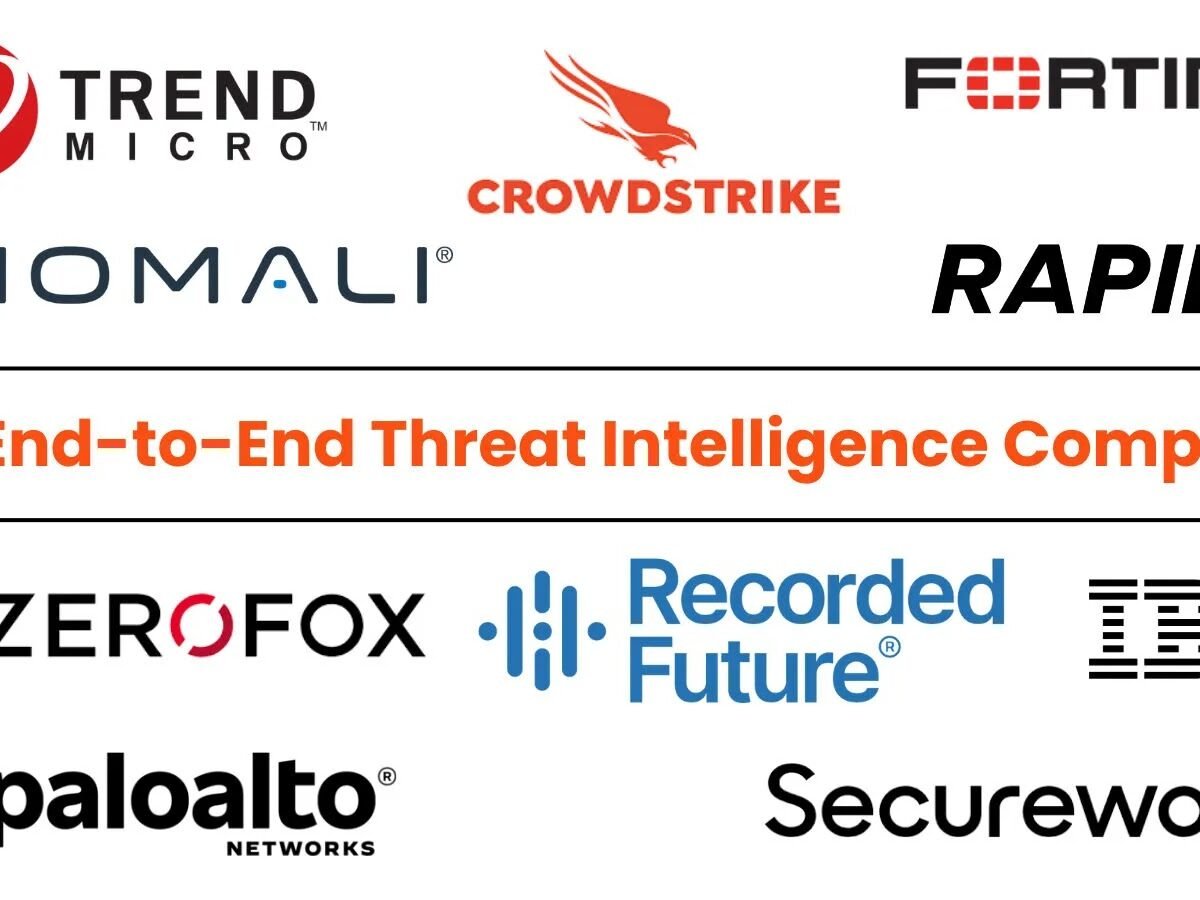The Rising Importance of End-to-End Threat Intelligence in 2025
In 2025, businesses are grappling with an increasingly perilous digital landscape. Cyberattacks have evolved in sophistication, targeting sensitive data, networks, and digital assets with alarming frequency. As a result, the demand for end-to-end threat intelligence solutions has surged, transforming them into vital investments for enterprises, governments, and even mid-sized companies alike.
End-to-end threat intelligence platforms furnish organizations with proactive insights, timely alerts, and actionable data needed to fend off emerging threats, including ransomware, phishing, insider attacks, and advanced persistent threats (APTs). This guide highlights the Top 10 Best End-to-End Threat Intelligence Companies in 2025, examining their features, strengths, and ideal applications for various types of businesses.
Choosing the Right Threat Intelligence Provider
Selecting the right threat intelligence provider is paramount, especially in a climate where cybercrime costs organizations trillions annually. The efficacy of a partnered cyber defense can significantly impact how well organizations detect, respond, and recover from incidents. These top companies stand out and highlight innovative features, proven reliability, AI-powered platforms, and global recognition for their robust security technologies.
The following overview emphasizes each provider’s relevance to modern cybersecurity needs and offers practical insights into their distinctive features.
Comparison Table: Top 10 Best End-to-End Threat Intelligence Companies 2025
(The comparison table would summarize the key features, strengths, and weaknesses of each company mentioned.)
1. Recorded Future
Why We Picked It
Recorded Future solidified its position as a frontrunner within the threat intelligence space, showcasing its AI-driven intelligence cloud platform. The company enables actionable insights across threat detection, vulnerability management, and even geopolitical risks. Its integration of machine learning and massive data repositories equips organizations with real-time threat context at scale.
Specifications
Recorded Future leverages advanced analytics powered by AI and machine learning, drawing insights from vast open-source and proprietary data feeds gathered daily.
Features
The platform includes predictive risks, vulnerability intelligence, dark web monitoring, and robust risk scoring capabilities.
Reason to Buy
Organizations often choose Recorded Future for its elimination of uncertainty in threat prioritization, leading to an enhanced security posture.
Pros
- Strong AI-driven risk analysis
- Extensive global datasets
- User-friendly interfaces
Cons
- Potentially higher costs
- Steeper learning curve for smaller teams
2. Anomali
Why We Picked It
Anomali shines by scaling its solutions across organizations of all sizes. Its ThreatStream platform offers centralized intelligence management enriched with third-party feeds, making it an ideal choice for collaborative security efforts.
Specifications
Anomali emphasizes cloud-native deployments featuring efficient API capabilities and enriched IOC feeds.
Features
Collaboration tools, enhanced forensic investigations, and seamless integrations help storage and SOC operations thrive.
Reason to Buy
Businesses prioritize cost-effectiveness and the ability for proactive investigation within Anomali’s offerings.
Pros
- Affordable and user-friendly
- Reliable AI analytical features
Cons
- Limited scalability for larger enterprises
- Requires some user training
3. IBM Corporation
Why We Picked It
IBM’s X-Force Threat Intelligence services continue to lead the market by combining decades of expertise with cutting-edge AI technology. Their holistic approach spans managed security services, incident response, and global insights.
Specifications
Integrating machine learning and dark web monitoring, IBM gathers billions of daily events from various enterprise systems.
Features
The platform excels in malware analysis and insider threat tracking while facilitating cloud workload protection.
Reason to Buy
IBM’s esteemed credibility and reputation make it a robust option for long-term, scalable partnerships.
Pros
- AI-powered insights through Watson
- Comprehensive portfolio integration
Cons
- Higher costs compared to niche providers
- Complexity may necessitate larger SOC teams
4. CrowdStrike
Why We Picked It
CrowdStrike’s Falcon Intelligence platform offers rapid endpoint protection, harnessing a cloud-native infrastructure that minimizes resource burden while maximizing visibility.
Specifications
Falcon features dynamic incident correlation and behavioral analysis, ensuring effective real-time responses.
Features
Key functionalities encompass malware sandboxing, automated correlation, and adversary profiling.
Reason to Buy
CrowdStrike serves enterprises seeking agile, endpoint-centric threat intelligence along with real-time response capabilities.
Pros
- Lightweight cloud-native solutions
- Rich adversary profiling database
Cons
- Higher fees for small businesses
- Reliance on stable network connectivity
5. Fortinet
Why We Picked It
Fortinet’s FortiGuard Labs specializes in comprehensive intelligence across endpoints, cloud, and network environments. Its real-time automated enforcement ensures businesses remain vigilant against threats.
Specifications
FortiGuard employs multi-vector data collection and powered anomaly detection to bolster cybersecurity posture.
Features
Core features like URL filtering and automated incident response offer proactive defense strategies.
Reason to Buy
Fortinet promotes a cohesive security approach by embedding intelligence directly into their security appliances.
Pros
- Seamless integration with Fortinet products
- Cost-effective enterprise capabilities
Cons
- Effectiveness best seen in Fortinet environments
- May require adaptations in mixed ecosystems
6. Palo Alto Networks
Why We Picked It
Palo Alto’s Unit 42 provides proactive intelligence and innovative research, enabling organizations to neutralize advanced threats effectively.
Specifications
The intelligence covers hybrid and multi-cloud workloads, along with zero-day and DDoS detection.
Features
Unit 42 promotes in-depth reporting, malware reverse engineering, and forensic analysis.
Reason to Buy
Companies gain layered intelligence critical for maintaining a secure perimeter across diverse infrastructures.
Pros
- Best-in-class zero-day detection
- Strong integration with firewall solutions
Cons
- Higher prices for smaller enterprises
- Potential need for training
7. Rapid7
Why We Picked It
Rapid7’s Insight Platform delivers action-oriented threat intelligence by combining detection, application security, and vulnerability management effectively.
Specifications
API-ready architecture and contextual analysis form the backbone of the Insight Platform.
Features
Proactive remediation guides and automated data enrichment ensure responsiveness.
Reason to Buy
Often sought after for its affordability and modularity, Rapid7 is perfect for organizations of varying sizes.
Pros
- User-friendly interface
- Comprehensive, affordable solutions
Cons
- Limited adversary profiling
- Scaling may be less effective in larger enterprises
8. LookingGlass
Why We Picked It
LookingGlass specializes in external threat intelligence and risk evaluation, offering critical insights into deep and dark web activity.
Specifications
Deep/dark web monitoring and third-party vendor exposure insights dominate the platform’s architecture.
Features
External attack surface mapping and threat actor analysis reinforce defense strategies.
Reason to Buy
Ideal for organizations with crucial supply chains looking for enhanced visibility against external risks.
Pros
- Strong dark web intelligence
- Vendor risk visibility
Cons
- Limited internal threat coverage
- Requires other SOC tool integrations
9. Secureworks
Why We Picked It
Secureworks’ Taegis platform unifies threat intelligence with managed detection and response, making it vital for enterprises aiming for hybrid intelligence solutions.
Specifications
Live SOC support and dynamic risk scanning are staples of their offering.
Features
Continuous monitoring and automated response workflows emphasize actionable insights.
Reason to Buy
Offers a balanced approach to intelligence and reliable support, tailored for mid-tier enterprises.
Pros
- Robust MDR integration
- Cost-effective compared to competitors
Cons
- Limited external threat visibility
- Best suited for mid-to-large businesses
10. Trend Micro
Why We Picked It
Trend Micro stands out with its Smart Protection Network, known for its comprehensive threat intelligence across varied domains.
Specifications
The platform emphasizes AI-enhanced scanning capabilities while offering extensive cross-channel coverage.
Features
Predictive threat detection and advanced malware sandboxing contribute to its strong performance metrics.
Reason to Buy
Organizations trust Trend Micro for its dependable reputation and ability to offer rapid threat discovery and response.
Pros
- Vast global dataset
- Proven reliability over decades
Cons
- Less advanced in niche profiling
- Integration adjustments may be necessary
The landscape of cybersecurity in 2025 is defined by an urgent need for proactive measures against evolving threats. Each of these ten companies offers unique strengths and features tailored to the varied needs of businesses, ensuring they are equipped to face challenges head-on. By selecting the right partner, organizations can enhance their defenses and significantly mitigate risks in an increasingly complex digital environment.





